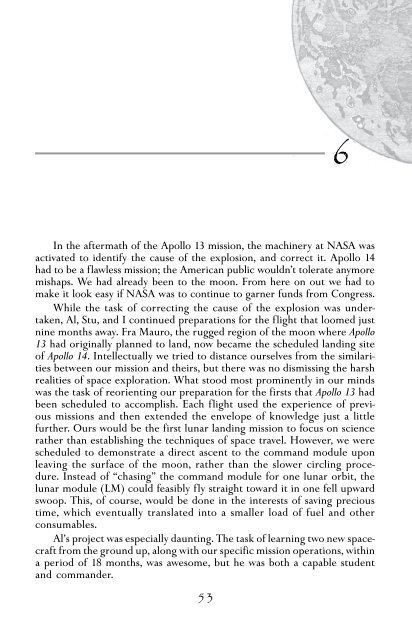edgar-mitchell
edgar-mitchell
edgar-mitchell
Create successful ePaper yourself
Turn your PDF publications into a flip-book with our unique Google optimized e-Paper software.
Sea of Grass 27<br />
disheveled. I had just begun my pilot school training, a process that would<br />
begin with aircraft driven by propeller, then the jet, and finally the rocket.<br />
And through it all Louise generally quieted her concerns; either that, or I<br />
was too wrapped up in what was happening outside the realm of home<br />
and family to notice.<br />
From the very beginning I was drawn to the cutting edge of flight<br />
technology as though by some mysterious force. And I was welcomed there.<br />
I suppose this was, in part, because I was naturally good at it; I could feel<br />
my way in the seat of an aircraft. There was a special sense in flying, as<br />
though the aircraft were an extension of my body, which made me stand<br />
out as a pilot. It lent me the perception that there was some larger purpose<br />
that I was fulfilling, which was of course immensely satisfying. But for a<br />
pilot’s wife, the lifestyle can be uneasy if not terrifying.<br />
I began my Navy career in the seat of an AT-6, which was then the<br />
Navy’s standard trainer. Not for some time would I climb into the cockpit<br />
of my first jet aircraft. Looking back on it now, the country seemed young<br />
and new then, with the advent of nuclear technology, the jet engine, and<br />
rocketry. The world itself seemed bright and colorful, poised for the<br />
extraordinary. Spaceflight was still only the dream of a handful of scientists.<br />
But when I did fly that first Navy jet, I knew this was where I was<br />
supposed to be.<br />
After my training in Pensacola, Louise, Karlyn, and I were again on the<br />
road, first to an advanced Navy training program, and then to the West<br />
Coast, where I’d be flying a large propeller aircraft, the P2V, for the next<br />
18 months. We purchased our first home on the rocky fog-shrouded slopes<br />
of Whidby Island, Washington, and settled in for our three-year stay. At<br />
the time, military life suited me insofar that it allowed me to fly. And I<br />
knew that aircraft and spacecraft would be the next medium of man’s<br />
exploration, just as the horse and ship had been in the past. Even as a<br />
young man in my early 20s I suppose I secretly held the dream of being one<br />
of those explorers.<br />
For three years in the Pacific I flew various aircraft that would play<br />
small roles in the Korean conflict and the Cold War. It was a tense time,<br />
not only for Americans in general, but for those young men and women<br />
sent off to that rather obscure corner of the globe. Toward the very end of<br />
my first overseas assignment, our plane was attacked by interceptors while<br />
on a routine night patrol near the city of Shanghai. The radar operator on<br />
my aircraft informed us that two jets were fast approaching in attack position.<br />
Somehow I anticipated what was about to happen—perhaps by some<br />
sense of intuition—because just as I thrust the controls forward, sending<br />
the P2V into a dive, my copilot and I saw the incandescent tracer bullets<br />
from one of the jets arc overhead. To call it a close call would be to minimize<br />
the threat. But that’s how it was for many of the men around me in their


